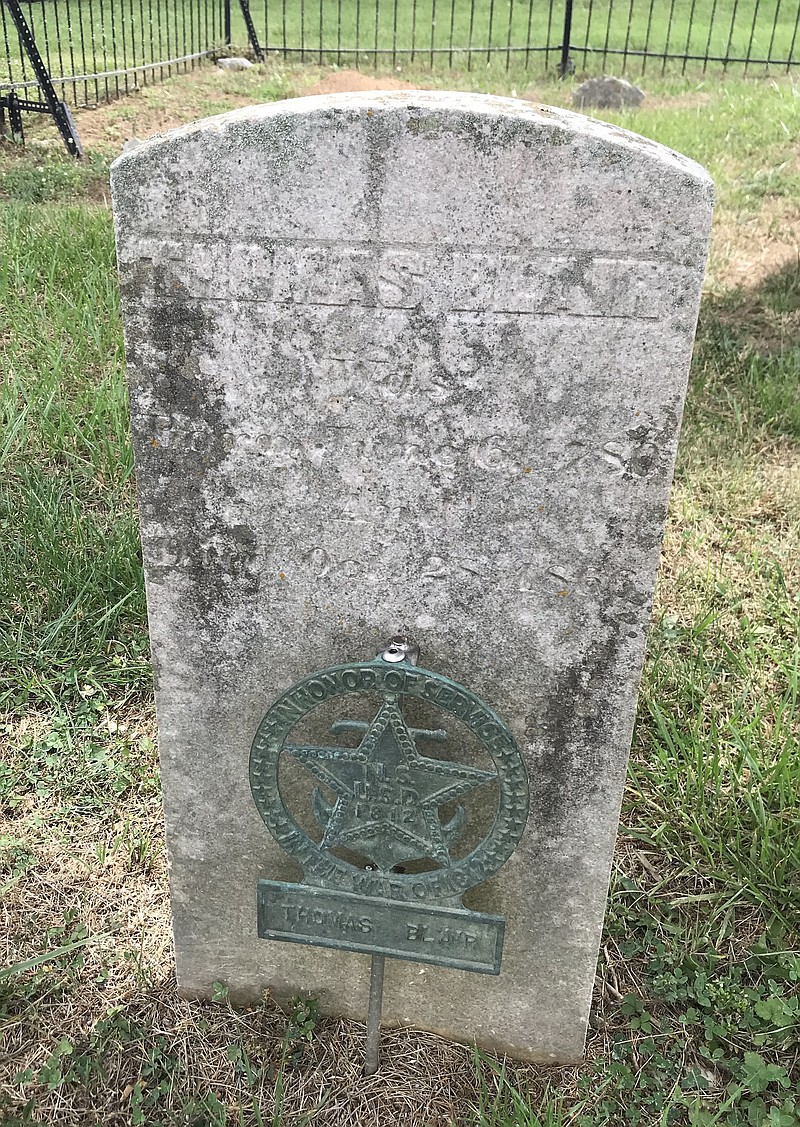Two tiny Hamilton County cemeteries beckon us to come explore and, though small, both are historical treasures: the Blair and DeTavernier cemeteries.
The Blair Cemetery, site of six marked and almost 30 unmarked graves, is located on the Georgetown-Ooltewah Highway, about two miles north of Mahan Gap Road. Of the six marked graves, the oldest belongs to Thomas Blair (1780-1866), a veteran of the War of 1812 and reportedly the son of John and Jane Gamble Blair. Thomas married Hannah Stone, daughter of Ezekiel Stone, a Revolutionary War veteran said to be buried in an unmarked grave in the Sequatchie Valley. The Blairs are joined in the cemetery by their son, Rev. Samuel J. Blair, and his wife, Nancy Louise Walker Blair, and two grandchildren, Lua C. Blair, age 34, and N. Howard Blair, age 6. The tiny cemetery, surrounded by a black wrought iron fence, is sheltered in a cluster of large cedar trees.
Census documents confirm that in 1830, the Blair family was living in Monroe County, Tennessee, but by 1850, Thomas and Hannah Blair were living in Murray County, Georgia. Thomas twice filed for bounty land based on his service in the War of 1812, first in 1851 for land in Murray County, Georgia, and then four years later for Catoosa County. Historical documents depict the Blairs as a moderately prosperous family, active in the Baptist church. Thomas often served as a deacon, and perhaps it was his influence that led his sixth son, Samuel Jefferson Blair (1823-1897), to become a prominent Baptist minister.
Church records, cited in "Sketches of Tennessee's Pioneer Baptist Preachers," recount Samuel Blair's early devotion to education, noting that he could frequently be found "burning the midnight pine knot" or engaging in extemporaneous debates in the local society he had founded. He would later recall that he made his profession of faith in 1842 and that he had been baptized into the "fellowship of the Madisonville church." In his biographical sketch, Samuel said, "standing at the water's edge surrounded by the fathers in Israel and looking on the clear, sparkling stream as it gushed from its fountain and wended its way so beautifully through the green meadows, I felt the first impressions to preach the gospel to a perishing world."
Blair organized his first church near Shepherd Hill, James County, and then organized the Hopewell Church, later serving congregations as pastor at Pleasant Grove, Antioch, Kandis Creek, Philippi, Blue Springs and Georgetown. He is mentioned in the Baptist Church records as a "man of positive convictions ready to take a stand for the right and a disposition to keep the peace and harmonize churches and communities." It was Samuel who, in January 1854, purchased the land where the cemetery stands. By his death in 1897, he owned almost 1,300 acres in the Long Savannah area.
The DeTavernier Cemetery, located between Harrison and Ooltewah on land formerly included in the 6,000-acre Voluntary Army Ammunition Plant property, was originally on farm land. With only three graves identified by markers, the tiny cemetery might well have disappeared without the Army's planned efforts, which included fencing the site along with posting a sign instructing visitors to not "molest" the graves. The cemetery takes its name from the most recognizable residents, Susan E. Carey de Tavernier (1834-1910) and her daughter, Annie (1866-1906).
However, Mrs. de Tavernier's husband is buried at the Chattanooga National Cemetery, Section S. He was born Frederick A.A. de Tavernier, Baron de Becu, in 1835 in Prussia, famous for its military domination on the continent.
In 1861, he chose to leave the royal court, arrived in New York City and was conscripted into the U.S. Army as a private. It can be assumed that he had previous military experience since military records note he quickly rose to first lieutenant in 1862 and was promoted to captain (1862) and then colonel (1863). By Dec. 5, 1865, de Tavernier was a resident of Campbell County, Tennessee, and had married Sue Carey, his royal title recorded on the marriage license. In 1870 and 1880, the family, with an only child, Annie, was still in Campbell County. He was recorded as a farmer with about $3,000 in real property. By his death in 1891, the family had relocated to Hamilton County and, because there are no descendants of this family, we may never know what brought them to the Harrison area unless it was the appeal of fertile farm land.
Our historic cemeteries both answer and ask questions.
Linda Moss Mines is the Chattanooga-Hamilton County historian and regent, Chief John Ross Chapter, NSDAR.
